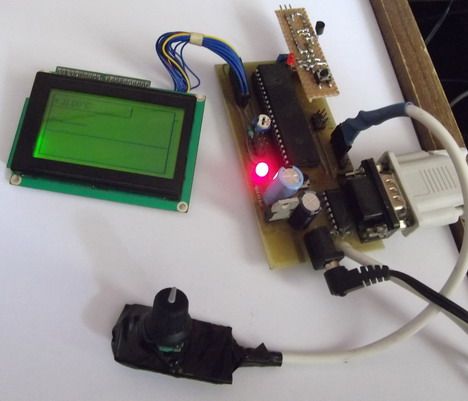Some time ago I’ve build a prototyping board with graphical LCD. It have served for various small projects and prototypes. Had a spare temperature sensor DS18B20 and decided to put simple temperature display project. GLCD board is equipped with Atmega32 microcontroller running at 16MHz. DS18B20 sensor is connected to port D pin 6.
LED connected to PD3 is used for indicating EEPROM write activity. Device is navigated with rotary encoder. It is connected to MCU as follows (more about interfacing rotary encoder here):
As you can see hardware is simple considering that you already have GLCD board. Next step is to decide what functionality is needed. I came up with following:
- Temperature display with 0.01ºC resolution;
- Time display in HH:MM:SS format;
- Date display in YYYY:MO:DD format;
- Date is calculated with leap year algorithm;
- Temperature is updated every 5s;
- Temperature data with date/time is sent to UART terminal;
- MIN and MAX temperature storage in EEPROM;
- Menu selectable functions: time/date set, temperature log view, graph plot, reset min max, stats view;
- LED blinks each time min or max is updated.
Reading DS18B20 sensor
Lets go through all parts of this. First of all temperature reading. As Atmega32 doesn’t have any hardware level 1-wire support everything has to be done in software. Luckily you can find ready libraries for this. As a reference I’ve used code example from here. Library is combination of several smaller that include 1-wire and DS18x20 code developed by Peter Dannegger and CRC code from Colin O’Flynn. All you need to initialize sensor, read its ROM code and then you can access sensor data with function that returns temperature value. Library supports multiple sensors connected to single wire so main code could be simplified since we need to read only one sensor. We are leaving as it is as long as it works. Temperature is stored as three 8-bit values: sign, integral part and decimal part. This way we avoid using floating point numbers that would take significant part of resources.
Time and date calculation
Time and date track is software based. This means that every second, minute, hour, day, month and year has to be calculated withing algorithm. To make one second ticks there is 16-bit timer1 used which generates overflow interrupts. On every interrupt time and date update function is called that increments value by one second as follows:
void TimeDate_Update(void)
{
if (++TD.ss==60)
{
TD.ss=0;
if(++TD.mm==60)
{
TD.mm=0;
if(++TD.hh==24)
{
TD.hh=0;
if(IsLeapYear(TD.year)&&(TD.mo==2))
{
if(++TD.dd>SDays[0])
{
TD.dd=1;
if(++TD.mo>12)
{
TD.mo=1;
TD.year++;
}
}
}
else if(++TD.dd>SDays[TD.mo])
{
TD.dd=1;
if(++TD.mo>12)
{
TD.mo=1;
TD.year++;
}
}
}
}
}
It also takes care of leap year calculation. It means if year is leap then February has 29 days otherwise it has 28. Leap year algorithm is common and can be found on internet:
For more detail: Temperature sensor with time and date display on graphical LCD using Atmega32

